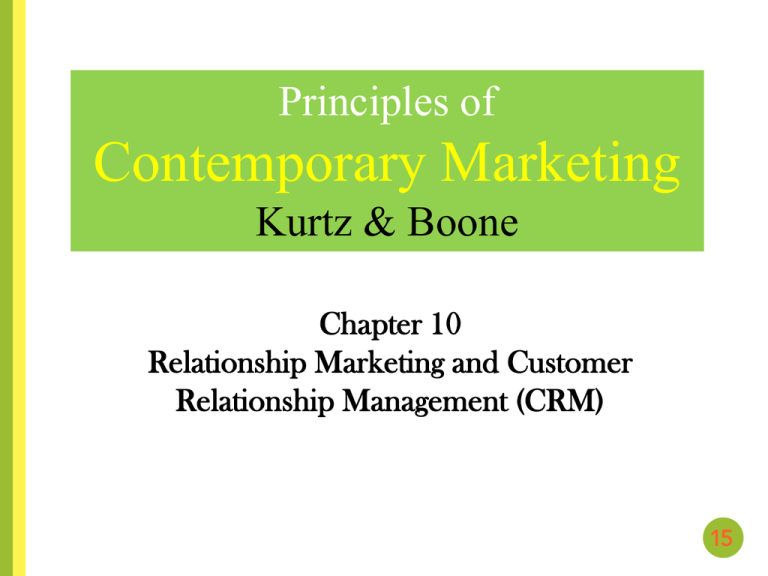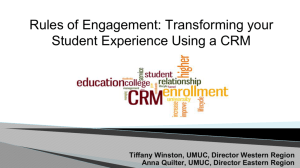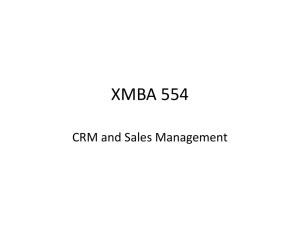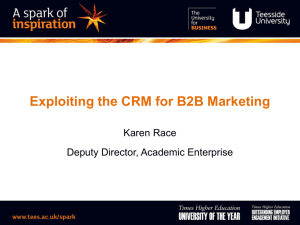
Principles of
Contemporary Marketing
Kurtz & Boone
Chapter 10
Relationship Marketing and Customer
Relationship Management (CRM)
CHAPTER 10 Relationship Marketing and Customer Relationship Management (CRM)
Chapter Objectives
1.
Contrast transaction-based marketing with relationship-based
marketing.
2.
Identify and explain the four basic elements of relationship
marketing, as well as the importance of internal marketing.
3.
Identify the three levels of the relationship marketing
continuum.
4.
Explain how firms can enhance customer satisfaction.
5.
Describe how companies build buyer-seller relationships.
Copyright © 2012 by South Western, a division of Cengage Learning. All rights reserved.
CHAPTER 10 Relationship Marketing and Customer Relationship Management (CRM)
Chapter Objectives
6.
Explain customer relationship management (CRM) and the
role of technology in building customer relationships.
7.
Describe the buyer-seller relationship in B2B marketing and
identify the four types of business partnerships.
8.
Describe how B2B marketing incorporates national account
selling, electronic data interchange and Web services, VMI,
CPFaR, managing the supply chains, and creating alliances.
9.
Identify and evaluate the most common measurement and
evaluation techniques within a relationship marketing
program.
Copyright © 2012 by South Western, a division of Cengage Learning. All rights reserved.
CHAPTER 10 Relationship Marketing and Customer Relationship Management (CRM)
The Shift from Transaction-Based Marketing
to Relationship Marketing
o Shift away from production-oriented marketing
o Emphasis on individual sales and transactions
o Limited communication
o No ongoing relationship
o Still common in some markets, such as residential real
estate
Copyright © 2012 by South Western, a division of Cengage Learning. All rights reserved.
CHAPTER 10 Relationship Marketing and Customer Relationship Management (CRM)
The Shift from Transaction-Based Marketing
to Relationship Marketing
o Shift toward relationship marketing
o Views customers as equal partners in transactions
o Encourages long-term relationships, repeat purchases,
and multiple brand purchases from the firm
o Leads to increased sales and low marketing costs
Copyright © 2012 by South Western, a division of Cengage Learning. All rights reserved.
CHAPTER 10 Relationship Marketing and Customer Relationship Management (CRM)
Copyright © 2012 by South Western, a division of Cengage Learning. All rights reserved.
CHAPTER 10 Relationship Marketing and Customer Relationship Management (CRM)
Relationship Marketing
o Focuses on long term rather than short term
o Emphasizes retaining customers over making a sale
o Ranks customer service as a high priority
o Encourages frequent customer contact
o Fosters customer commitment with the firm
o Bases customer interactions on cooperation and trust
o Commits all employees to provide high-quality
products
Copyright © 2012 by South Western, a division of Cengage Learning. All rights reserved.
CHAPTER 10 Relationship Marketing and Customer Relationship Management (CRM)
Copyright © 2012 by South Western, a division of Cengage Learning. All rights reserved.
CHAPTER 10 Relationship Marketing and Customer Relationship Management (CRM)
Copyright © 2012 by South Western, a division of Cengage Learning. All rights reserved.
CHAPTER 10 Relationship Marketing and Customer Relationship Management (CRM)
How Marketers Keep Customers
o Frequency marketing - Frequent-buyer or user
marketing programs that reward customers with cash,
rebates, merchandise, or other premiums
o Affinity marketing - Marketing effort sponsored by an
organization that solicits responses from individuals
who share common interests and activities
Copyright © 2012 by South Western, a division of Cengage Learning. All rights reserved.
CHAPTER 10 Relationship Marketing and Customer Relationship Management (CRM)
Database Marketing
o Interactive television - Television service package that
includes a return path for viewers to interact with
programs or commercials by clicking their remote
controls
o Application service providers (ASPs) – Outside
companies that specialize in providing both the
computers and the application support for managing
information systems of business clients
Copyright © 2012 by South Western, a division of Cengage Learning. All rights reserved.
CHAPTER 10 Relationship Marketing and Customer Relationship Management (CRM)
Customers as Advocates
o Grassroots marketing - Connecting directly with
existing and potential customers through
nonmainstream channels
o Viral marketing - Satisfied customers get the word
about products out to other consumers
o Buzz marketing - Relies on volunteers to try products
and then talk abut their experiences with friends and
colleagues
Copyright © 2012 by South Western, a division of Cengage Learning. All rights reserved.
CHAPTER 10 Relationship Marketing and Customer Relationship Management (CRM)
Customer Relationship Management
o Combination of strategies and tools that drives
relationship programs, reorienting the entire
organization to a concentrated focus on satisfying
customers
o Leverages technology to manage customer
relationships and integrate all stakeholders into a
company’s product design and development
Copyright © 2012 by South Western, a division of Cengage Learning. All rights reserved.
CHAPTER 10 Relationship Marketing and Customer Relationship Management (CRM)
Retrieving Lost Customers
o Customers leave for a variety of reasons:
o Boredom
o Move to a new location
o No longer have a need for the product
o Prefer competing products
o Customer winback - Process of rejuvenating lost
relationships with customers
Copyright © 2012 by South Western, a division of Cengage Learning. All rights reserved.
CHAPTER 10 Relationship Marketing and Customer Relationship Management (CRM)
Buyer-Seller Relationships in
Business-to-Business Markets
o Business-to-business marketing - Involves
organization’s purchase of goods and services to
support company operations or production of other
products
Copyright © 2012 by South Western, a division of Cengage Learning. All rights reserved.
CHAPTER 10 Relationship Marketing and Customer Relationship Management (CRM)
Types of Partnerships
o Buyer partnership
o Seller partnership
o Internal partnerships
o Lateral partnerships
Copyright © 2012 by South Western, a division of Cengage Learning. All rights reserved.
CHAPTER 10 Relationship Marketing and Customer Relationship Management (CRM)
Cobranding and Comarketing
o Cobranding - Cooperative arrangement in which two
or more businesses team up to closely link their names
on a single product
o Comarketing - Cooperative arrangement in which two
businesses jointly market each other’s products
Copyright © 2012 by South Western, a division of Cengage Learning. All rights reserved.
CHAPTER 10 Relationship Marketing and Customer Relationship Management (CRM)
Electronic Data Exchanges and Web Services
o Electronic data interchanges (EDI) - Computer-tocomputer exchanges of invoices, orders, and other
business documents
o Quick-response merchandising - A just-in-time strategy
that reduces the time merchandise is held in inventory
o Web services – Platform-independent information
exchange systems that use the Internet to allow
interaction between the firms
Copyright © 2012 by South Western, a division of Cengage Learning. All rights reserved.
CHAPTER 10 Relationship Marketing and Customer Relationship Management (CRM)
Business-to-Business Alliances
o Strategic alliances - Partnership formed to create a
competitive advantage
o Improve supply chain relationships and enhance
operating flexibility
o Can be a new operation in which alliance partners
each have an ownership stake
o May be less formal, such as jointly establishing a newproduct design team
Copyright © 2012 by South Western, a division of Cengage Learning. All rights reserved.
CHAPTER 10 Relationship Marketing and Customer Relationship Management (CRM)
Evaluating Customer Relationship Programs
o Lifetime value of a customer - Revenues and intangible
benefits a customer brings to the seller over an average
lifetime, less the amount the company must spend to
acquire, market to, and service the customer
o May influence the types of customers a firm tries to
reach
o Example: Lexus targets former owners of Mercedes and
Cadillac cars
Copyright © 2012 by South Western, a division of Cengage Learning. All rights reserved.







